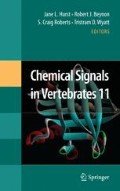Abstract
Preliminary investigations have been conducted to identify the chemical composition of carpal gland secretions from feral pigs in the lowland tropical rainforest of NE Australia. Carpal glands are located along the inner part of the front legs and their secretion may be distributed to the surrounding vegetation and bedding sites. Secretions were collected from the external surface of the glands by swabbing with filter paper discs. Compounds were then extracted in distilled ether and analysed by capillary gas chromatography. Secretions from boars and reproductive females contained more compounds than those from non-reproductive females. Only seventeen compounds were found in the secretions collected from boars and reproductive females, while one compound was only present in secretions from reproductive females. In boars compounds were at higher concentrations than in reproductive females. Lowest concentrations were found in non-reproductive females. Boars and reproductive females have more compounds with a higher molecular weight than non-reproductive females. The similarity in the chemical composition of carpal gland secretions from boars and reproductive females may be responsible for the same response that these animals trigger in conspecifics, i.e. avoidance behaviour. Further investigations will focus on the potential these secretions may have as repellents in feral pig control.
Access this chapter
Tax calculation will be finalised at checkout
Purchases are for personal use only
Preview
Unable to display preview. Download preview PDF.
Reference
Alberts, AC (1992) Constraints on the design of chemical communication systems in terrestrial vertebrates. Amer. Nat., Supplement 1992, 62–89.
Albone, E.S. (1984) Mammalian Semiochemistry. Chichester. John Wiley & Sons Limited, New York, Brisbane, Toronto, Singapore.
Booth, W.D. and White, C.A. (1988) The isolation, purification and some properties of pheromaxin, the pheromonal steroid-binding protein, in porcine submaxillary glands and saliva. J. Endocrin. 118, 47–57.
Byers, J.A. (1978) Probable involvement of the preorbital glands in two social behavioural patterns of the collared peccary, Dicotyles tajacu. J. Mammal. 59, 855–856.
Choquenot, D., McIlroy, J. and Korn, T. (1996) Managing Vertebrate Pests: Feral Pigs. Bureau of Resource Sciences/ Australian Government Publishing Service, Canberra.
Gargiulo, A.M.; Pedini, V. and Ceccarelli, P. (1989) Histology, ultrastructure and carbohydrate histochemistry of pig carpal glands. Anat. Histol. Embryol. 18, 289–296.
Gosling, L.M. (1985) The even-toed ungulates: order Artiodactyla. In: R.E. Brown and D.W. Macdonald (Eds.), Social odours in mammals. Vol 2, Clarendon Press, Oxford, pp. 550–618.
Güntherschulze, J. (1979) Studies about Regio olfactoria of wild boar (Sus scrofa) and the domestic pig (Sus scrofa domestica). Zool. Anz. Jena 202, 256–279.
Heise-Pavlov, P.M. and Heise-Pavlov, S.R. (2003) Feral pigs in tropical lowland rainforest in north eastern Australia: ecology, zoonoses and management. Wildl. Biol. 9, 29–36.
Heise-Pavlov, S., Heise-Pavlov, P. and Bradley, A. (2005) Carpal Glands in feral pigs (Sus domesticus) in tropical lowland rainforest in NE Queensland, Australia. J. Zool. 266, 73–80.
Hraste, A. and Stojkovic, R. (1995) Histomorphologic and histochemical chararcteristics of carpal glands (glandulae carpeae) in domestic swine (Sus scrofa domesticus) and wild swine (Sus scrofa ferus). Anatomia, Histologia, Embryologia 24 (3), 209.
Marchese, S. Pes, D.; Scaloni, A. Carbone, V. and Pelosi, P. (1998): Lipocalins of boar salivary glands binding odours and pheromones. Eur. J. Biochem. 252, 563–568.
Martys, M. (1977) Das flehmen der schweine, Suidae - The flehmen behaviour of pigs. Zool. Anz. Jena 199: 433–440.
Mayer, J.J. and Brisbin, I.L. (1986) A note on the scent-marking behaviour of two captive-reared feral boars. Appl. Anim. Behav. Sci. 16, 85–90.
McGlone, J.J. and Anderson, D.L. (2002) Synthetic maternal pheromone stimulates feeding behaviour and weight gain in weaned pigs. J. Anim. Sci 80, 3179–83.
McIlroy, J.C. and Gifford, E.J. (2005) Are oestrous feral pigs, Sus scrofa, useful as trapping lures?. Wildl. Res. 32 (7), 605–608.
Melrose, D.R. Reed, H.C.B. and Patterson, R.L.S. (1971) Androgen steroids associated with boar odour as an aid to the detection of oestrus in pig artificial insemination. Brit. Vet. J. 127, 497–501.
Meynhardt, H. (1982) Schwarzwild-Report., Verlag J. Neumann-Neudamm Melsungen, Berlin, Basel, Wien.
Mueller-Schwarze, D. (1979) Flehmen in the context of mammalian urine communication.- In: F.J. Ritter (Ed.), Chemical ecology: Odour communication in animals, Elsevier/North Holland Biomedical Press, Amsterdam, pp. 85–96.
Pedini, V., Scocco, P., Dall’Aglio, C. and Gargiulo, A.M. (1999) Detection of glycosidic residues in carpal glands of wild and domestic pig revealed by basic and lectin histochemistry. Anat. Anz. 181 (3), 269–274.
Robertson, D.H., Cox, K.A., Gaskell, S.J., Evershed, R.P. and Beynon, R.J. (1996) Molecular heterogeneity in the Major Urinary Proteins of the house mouse Mus musculus. Biochem. J. 316, 265–272.
SCA Technical Report Series, No. 34. (1996) Feral Livestock Animals – Destruction or Capture, Handling and Marketing; Standing Committee on Agriculture, Animal Health Committee—Model Code of Practice for the Welfare of Animals. Canberra.
Spencer, P.B.S., Lapidge, S.J., Hampton, J.O. and Pluske, J.R. (2005) The sociogenetic structure of a controlled feral pig population. Wildl. Res. 32, 297–304.
Stinson, C.G. and Patterson, R.L.S. (1972) C19-Δ16 steroids in boar sweat glands. Brit. Vet. J. 128, 245–267.
Waterhouse, J.S., Hudson, M., Pickett, J.A. and Weldon, P.J. (2001) Volatile components in dorsal gland secretions of the white-lipped peccary, Tayassu pecari, from Bolivia. J. Chem. Ecol. 27, 2459–2469.
Veltman, C.J., Cook, C.J., Drake, K.A. and Devine, C.D. (2001) Potential of delta-decanolactone and (Z)-7-dedecen-1-yl acetate to attract feral goats (Capra hirsus). Wildl. Res. 28, 589–597.
Wyatt, T.D. (2003) Pheromones and Animal Behaviour: Communication by Smell and Taste. Cambridge University Press.
Zeng, C., Spelman, A.I., Vowels, B.R., Leyden, J.J., Biemann, K. and Preti, G. (1996) A human axillary odorant is carried by apolipoprotein D. Proc. Natl. Acad. Sci. USA 93, 6626–6630.
Author information
Authors and Affiliations
Editor information
Editors and Affiliations
Rights and permissions
Copyright information
© 2008 Springer Science+Business Media,LLC
About this paper
Cite this paper
Heise-Pavlov, S.R., Logan, J.G., Pickett, J.A. (2008). Pig Semiochemicals and Their Potential for Feral Pig Control in NE Australia. In: Hurst, J.L., Beynon, R.J., Roberts, S.C., Wyatt, T.D. (eds) Chemical Signals in Vertebrates 11. Springer, New York, NY. https://doi.org/10.1007/978-0-387-73945-8_38
Download citation
DOI: https://doi.org/10.1007/978-0-387-73945-8_38
Publisher Name: Springer, New York, NY
Print ISBN: 978-0-387-73944-1
Online ISBN: 978-0-387-73945-8
eBook Packages: Biomedical and Life SciencesBiomedical and Life Sciences (R0)

